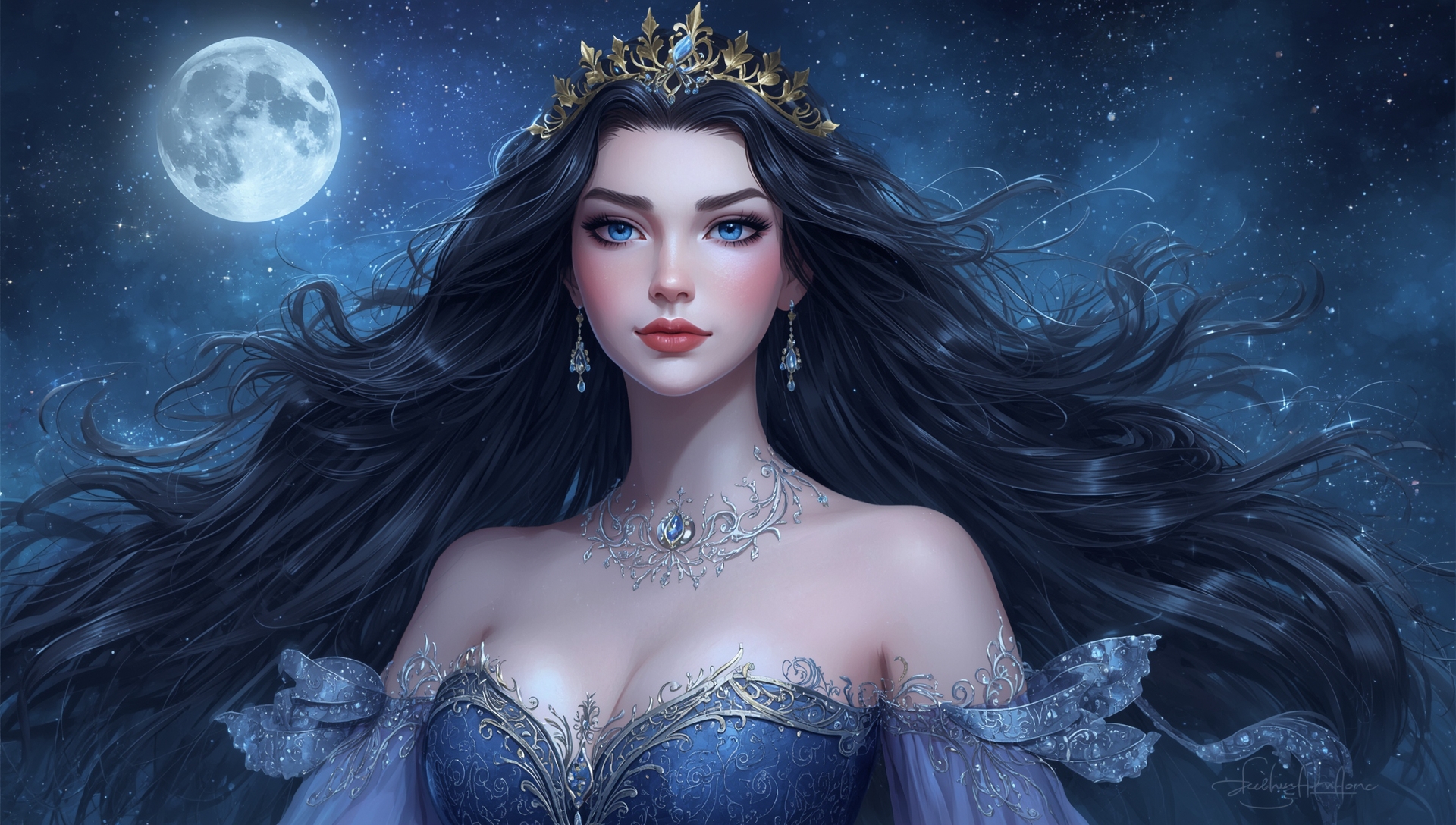We have another Wordweavers meeting (one of my two writing groups) today and the theme that we have to write a 1000-word story about is “Black.” Both reading and writing have long been effective stress management strategies for me, so writing this story was no hardship for me. I did, however, want to try something new, I wanted to tackle a contraventional genre, “fairy tales for adults.”
So, a fair amount of research later (see below and thank you Perplexity), I came up with this story:
Once upon a time, in a realm where the sun had forgotten how to rise, there existed a kingdom shrouded in perpetual darkness. The Kingdom of Eternal Night was not a place of sorrow, as one might expect, but a land of extraordinary beauty where everything gleamed like polished obsidian under the light of a thousand silver stars.
In the heart of this mystical kingdom stood a palace carved entirely from black marble, its towers reaching toward the star-filled sky like elegant fingers. Within these walls lived Princess Nyx, whose hair was as dark as a moonless midnight and whose eyes sparkled like fragments of the night sky itself. Unlike the golden-haired princesses of neighbouring lands, Nyx possessed a beauty that was both mysterious and profound, like the depths of a still, dark lake.
The princess had been born with an unusual gift: she could weave shadows into solid forms. With a graceful gesture of her hands, she could create bridges from darkness, craft flowers that bloomed in shades of deepest violet and midnight blue, and even fashion gowns that shimmered with the essence of starlight captured in silk. Her people adored her, for in their world of eternal night, her powers brought wonder and utility in equal measure.
However, beyond the borders of the Kingdom of Eternal Night lay the Bright Lands, where the sun blazed without mercy and the people feared anything that cast a shadow. These lands were ruled by King Aurelius, whose golden armour reflected light so intensely that it could blind those who looked upon him directly. His knights, clad in white and silver, patrolled the borders between the kingdoms, ensuring that no darkness crept into their realm.
One fateful day, a terrible curse befell both kingdoms. A jealous sorceress named Umbra, who had been banished from both realms for her cruelty, cast a spell that began to steal all colour from the world. Starting from the borderlands between the kingdoms, a creeping greyness spread like spilt ink on parchment, draining the vibrant blacks of Nyx’s realm and the brilliant golds and whites of Aurelius’s domain.
As the curse spread, the people of both kingdoms began to sicken. In the Bright Lands, without their blazing sun and golden fields, the inhabitants grew weak and listless. In the Kingdom of Eternal Night, as their beautiful blacks faded to dull gray, the stars began to dim and Princess Nyx found her shadow-weaving powers growing weaker each day.
Desperate to save their people, Princess Nyx made a decision that shocked her advisors. She would cross into the Bright Lands and seek an audience with King Aurelius. Many of her subjects feared that the intense light of his realm would destroy her, for it was believed that creatures of darkness could not survive in places of such brilliance.
Donning a cloak woven from the deepest shadows her weakening powers could muster, Princess Nyx ventured forth. As she crossed the border, the sunlight struck her like a physical blow, but to her amazement, she did not crumble to ash as the old tales suggested. Instead, where the light met her dark cloak, beautiful patterns emerged—not grey, but a rich interplay of light and shadow that created new colours entirely.
King Aurelius, witnessing her approach from his crystal tower, was prepared to order his knights to turn her away. But when he saw how the light and shadow danced around her, creating beauty rather than destruction, he found himself curious rather than afraid.
“Princess of Darkness,” he called from his tower, his voice carrying across the courtyard, “why do you come to my realm of light?”
“King of Brightness,” she replied, her voice strong despite her exhaustion, “I come because our kingdoms are both dying. The curse that steals our colours threatens all we hold dear. Neither pure light nor pure darkness can stop it—but perhaps together, we might find the strength.”
Aurelius descended from his tower, and for the first time, he looked upon true darkness without fear. As he approached Nyx, his radiant armour cast sharp shadows, while her presence seemed to give his light new depth and meaning. Where they stood together, the creeping greyness halted its advance.
“You speak wisdom,” Aurelius admitted. “I have watched my golden fields fade to ash, and I suspect your star-filled nights have grown dim as well.”
Together, they devised a plan. If the curse fed on separation between light and dark, perhaps unity could starve it. Hand in hand, the king of light and the princess of darkness walked to the exact centre of the borderland, where the curse was strongest.
There, Princess Nyx wove her remaining shadows while King Aurelius channelled his brightest light. But instead of fighting each other, they worked in harmony. Nyx’s shadows gave shape and depth to Aurelius’s brilliance, while his light revealed the subtle beauty within her darkness. Together, they created something neither could achieve alone: a perfect balance that was more beautiful than either pure light or pure darkness.
The curse, which fed on division and fear, could not withstand this unity. Like morning mist touched by dawn, Umbra’s spell began to dissolve. Colour returned to both kingdoms—the rich, velvety blacks of the Kingdom of Eternal Night, and the warm, golden hues of the Bright Lands. But now, where the two realms met, there existed a new territory of twilight and dawn, where light and shadow danced together in eternal harmony.
From that day forward, Princess Nyx and King Aurelius ruled as allies, their kingdoms no longer divided by fear of the other’s nature. They learned that true beauty came not from the absence of light or darkness, but from the graceful interplay between them. And in the borderland where twilight reigned, the people of both kingdoms would come to witness the daily miracle of how shadows could make light more beautiful, and how light could reveal the hidden treasures within darkness.
And they all lived happily ever after, in a world where black was not feared but celebrated as part of the magnificent tapestry of existence.
Why should we read (and write!) fairy tales?
Fairy tales serve as powerful vehicles for teaching valuable lessons because they package complex moral and practical wisdom into memorable, emotionally engaging stories. Here’s how they accomplish this educational role:
Universal Themes in Accessible Form
Fairy tales distil universal human experiences—good versus evil, love and loss, growth and transformation—into simple narratives that even children can understand. A story like “The Tortoise and the Hare” teaches perseverance more effectively than a lecture about persistence because it creates a vivid, memorable scenario that illustrates the principle in action.
Safe Exploration of Difficult Topics
These stories provide a safe psychological space to explore frightening or challenging concepts. Children can process ideas about death, betrayal, or injustice through the buffer of fantasy. When Hansel and Gretel face abandonment and danger, young listeners can experience and work through their own fears of being left alone or encountering harm, all while knowing they’re in the safety of a story.
Moral Frameworks and Consequences
Fairy tales typically present clear moral frameworks where actions have consequences. Characters who are kind, brave, or honest are rewarded, while those who are cruel, cowardly, or dishonest face negative outcomes. This helps develop moral reasoning and understanding of cause and effect in human behaviour.
Cultural Values and Social Learning
These stories transmit cultural values across generations, teaching about cooperation, family loyalty, respect for elders, and community responsibility. They show how societies expect people to behave and what qualities are valued or discouraged.
Problem-Solving and Resilience
Many fairy tales feature protagonists who overcome seemingly impossible obstacles through cleverness, determination, or help from others. This teaches valuable lessons about resourcefulness, the importance of seeking help when needed, and the reality that challenges can be overcome with the right approach and persistence.
Emotional Intelligence Development
Fairy tales help develop emotional intelligence by presenting characters experiencing a full range of emotions and showing how these feelings influence behavior and outcomes. Readers learn to identify emotions, understand their consequences, and develop empathy for others’ experiences.
Symbolic Thinking and Metaphor
The symbolic nature of fairy tales—where forests represent the unknown, mirrors reflect truth, and transformations symbolise growth—helps develop abstract thinking skills. This symbolic literacy becomes valuable in understanding literature, art, and even complex social and political concepts later in life.
Memory and Retention
Stories are inherently more memorable than abstract principles. The narrative structure, vivid imagery, and emotional engagement help ensure that lessons stick with us long after we’ve heard them. Many adults can still recall fairy tales from childhood and the lessons they contained.
Flexibility of Interpretation
Unlike rigid moral instruction, fairy tales can be interpreted differently at various life stages. A child might focus on the adventure in “Little Red Riding Hood,” while an adult might see lessons about stranger danger, the importance of following parental guidance, or even feminist themes about female agency and survival.
Hope and Optimism
Most fairy tales, despite containing dark elements, ultimately convey hope and the possibility of positive change. This optimistic worldview can be particularly valuable during difficult times, teaching that circumstances can improve and that good ultimately prevails.
The enduring power of fairy tales lies in their ability to teach without preaching, to make the complex simple without making it simplistic, and to prepare us for life’s challenges while still allowing us to believe in the possibility of “happily ever after.”
Adult fairy tales promote resilience by encouraging emotional processing, imaginative problem-solving, and symbolic reframing of adversity, often more deeply and creatively than other narrative therapies. Several studies highlight the unique contributions and mechanisms of fairy tale-based approaches compared to general narrative therapies. (Ruini C, Masoni L, Ottolini F, Ferrari S. Positive Narrative Group Psychotherapy: the use of traditional fairy tales to enhance psychological well-being and growth. Psychol Well Being. 2014;4(1):13.)
How Adult Fairy Tales Build Resilience
Research shows that adult fairy tales offer psychological, emotional, and educational benefits, including personal growth, emotional processing, and enhanced creativity and literacy skills, but the one possible effect that caught my attention is increased resilience, especially valuable to my cliens who struggled to manage their stress.
Fairy tales use metaphor, archetype, and “darkness-to-light” plots that help adults explore challenges and visualise triumph over adversity—heightening hope and resourcefulness.
Structured fairy tale writing and group discussion allow people to detach emotionally, symbolically process trauma, and create new positive outcomes (happy endings), giving form to desires and confidence in future possibilities.
The classic fairy tale format—challenges, transformation, resolution—mirrors psychological journeys, making it easier for adults to imagine adaptive responses and personal growth. (Ruini C, Mortara CC. Writing Technique Across Psychotherapies-From Traditional Expressive Writing to New Positive Psychology Interventions: A Narrative Review. J Contemp Psychother. 2022;52(1):23-34.)
Comparison: Fairy Tale Therapy vs Other Narrative Therapies
| Therapy Type | Resilience Mechanisms | Features Unique to Fairy Tales |
|---|---|---|
| Fairy Tale Therapy | Metaphorical distance; symbol-rich detachment; guided rewriting towards “happy endings”; integration of creative abilities | Use of archetypes, magical helpers, and mythic journey motifs enhance meaning-making and imaginative coping |
| Standard Narrative Therapy | Life-story reframing; separating individual from problems; meaning-making through personal narration | Focuses on real-world events and autobiographical memory; less use of symbolic or fantastical narrative |
Evidence and Clinical Insights
- Research shows that participants in fairy tale group therapy report greater personal growth, self-acceptance, and appreciation of life, as well as reductions in anxiety—signifying stronger resilience outcomes.
- Fairy tales engage the imagination and creative problem-solving in ways that mere personal narratives may not, helping individuals envision solutions outside their usual cognitive frames.
- Writing or discussing fairy tales allows patients to practice cognitive defusion and emotional detachment (similar to processes in Acceptance and Commitment Therapy), facilitating flexible thinking and hope. (Golden AJ, Hančević Horvat N, Jakovljević M. Acceptance and Change as Dialectic of Recovery: Examples of Storytelling, Fairy Tale and Psychopharmacotherapy as Therapeutic Modalities. Psychiatr Danub. 2021 Spring-Summer;33(Suppl 4):1130-1139. PMID: 35354179.)
Overall, adult fairy tales foster resilience by combining narrative therapy’s reframing strengths with symbolic, creative, and emotionally safe tools unique to the fairy tale format—resulting in deeper transformation for many adults. (Hou C, Foscht T, Duffek B, Arigayota A, Eisingerich AB Mitigating the Negative Effects of Internet Browsing on Young People’s Resilience and Outlook on Life Through Classic Grimms’ Fairy Tales: Exploratory Randomised Controlled Study JMIR Form Res 2025;9:e76770
Discover Your Own Story on a 1000-year-old Path
Just as fairy tales have guided travellers through life’s journeys for centuries, there’s something magical about walking an ancient pilgrimage route that has inspired countless stories of transformation. If you’re drawn to exploring the deeper narratives of your own life—much like the characters in our beloved tales who venture into unknown territories to discover their true selves—consider joining us on a writing retreat along the Camino de Santiago in Southwest France.
There’s a unique alchemy that happens when you combine the rhythm of walking with the craft of storytelling. Each step on these time-worn paths seems to unlock new chapters of creativity and self-discovery. Our retreats offer writers and dreamers the chance to immerse themselves in both the physical journey and the inner adventure of crafting their own meaningful stories.
Whether you’re working on your first fairy tale, a personal memoir, or simply seeking inspiration for your next creative project, the Camino provides the perfect backdrop for both reflection and writing. Like the heroes and heroines of classic tales, sometimes we need to step away from our familiar kingdoms to find the stories we’re truly meant to tell.
If this calls to you, I’d love to share more about my DIY Camino de Santiago walking and writing retreats. Sometimes the most powerful stories begin with a single step onto an ancient path.

Firm Foundations for Your Future Protocol – a fast-paced, high-impact, future-focused course that facilitates the construction of identity-shaping stories about your future self so that you can make the changes needed to avoid having to go through big life changes again and again—without needing to process your past in depth and in detail.

“I am an experienced medical doctor – MBChB, MRCGP, NLP master pract cert, Transformational Life Coach (dip.) Life Story Coach (cert.) Stress Counselling (cert.) Med Hypnotherapy (dip.) and EAGALA (cert.) I may have an impressive number of letters after my name, and more than three decades of professional experience, but what qualifies me to excel at what I do is my intuitive understanding of my clients’ difficulties and my extensive personal experience of managing major life changes using strategies I developed over many years.” Dr M Montagu

